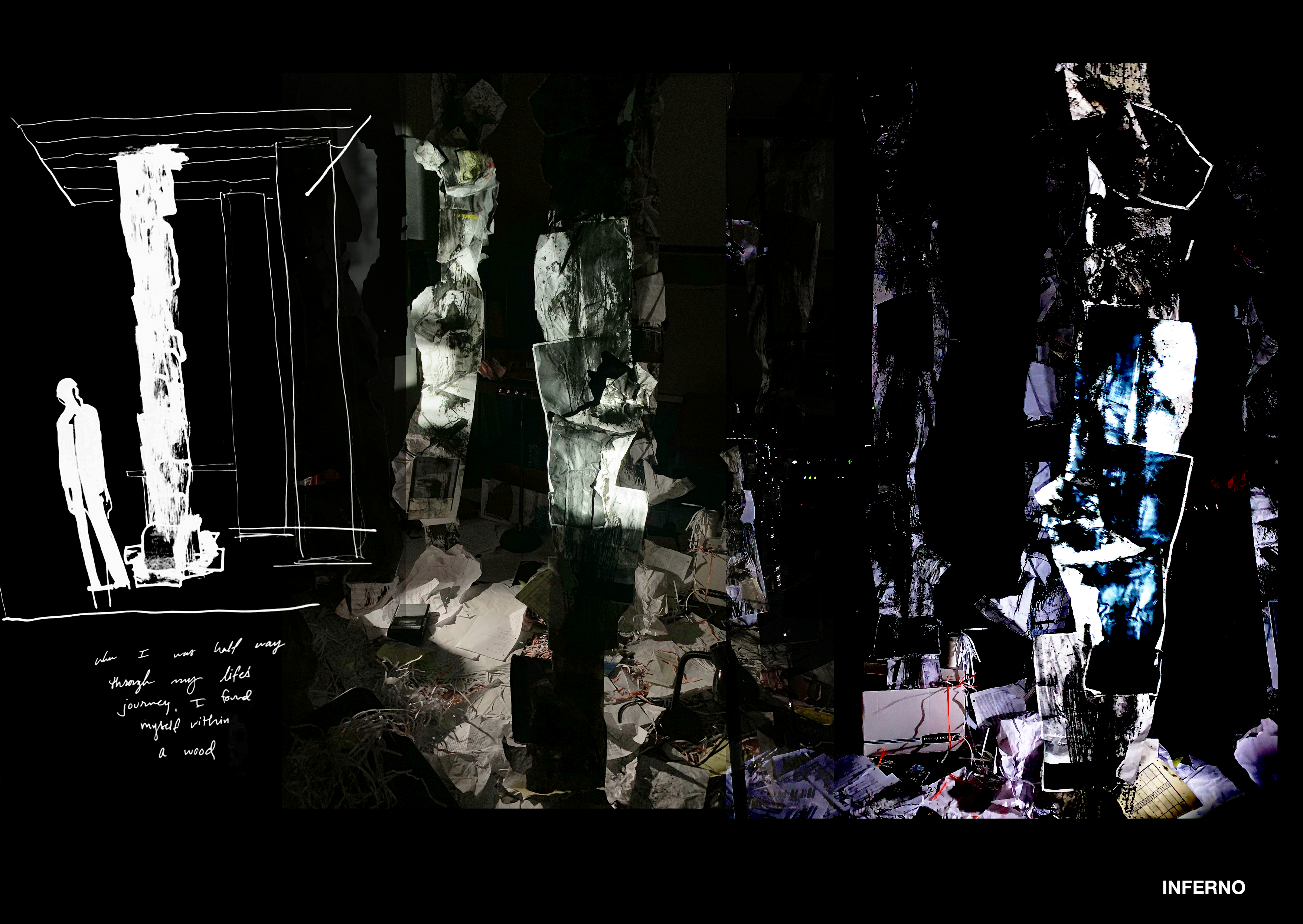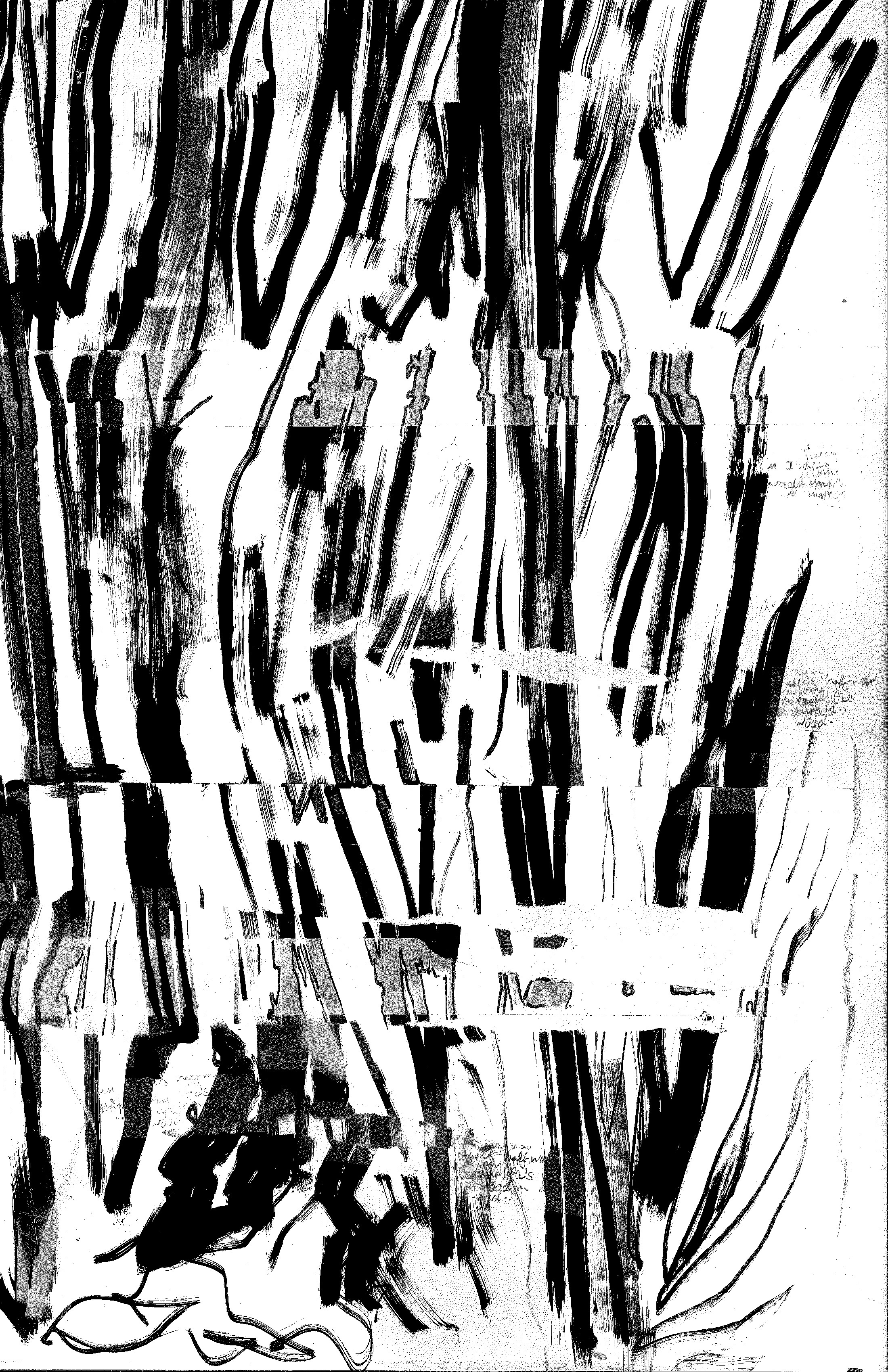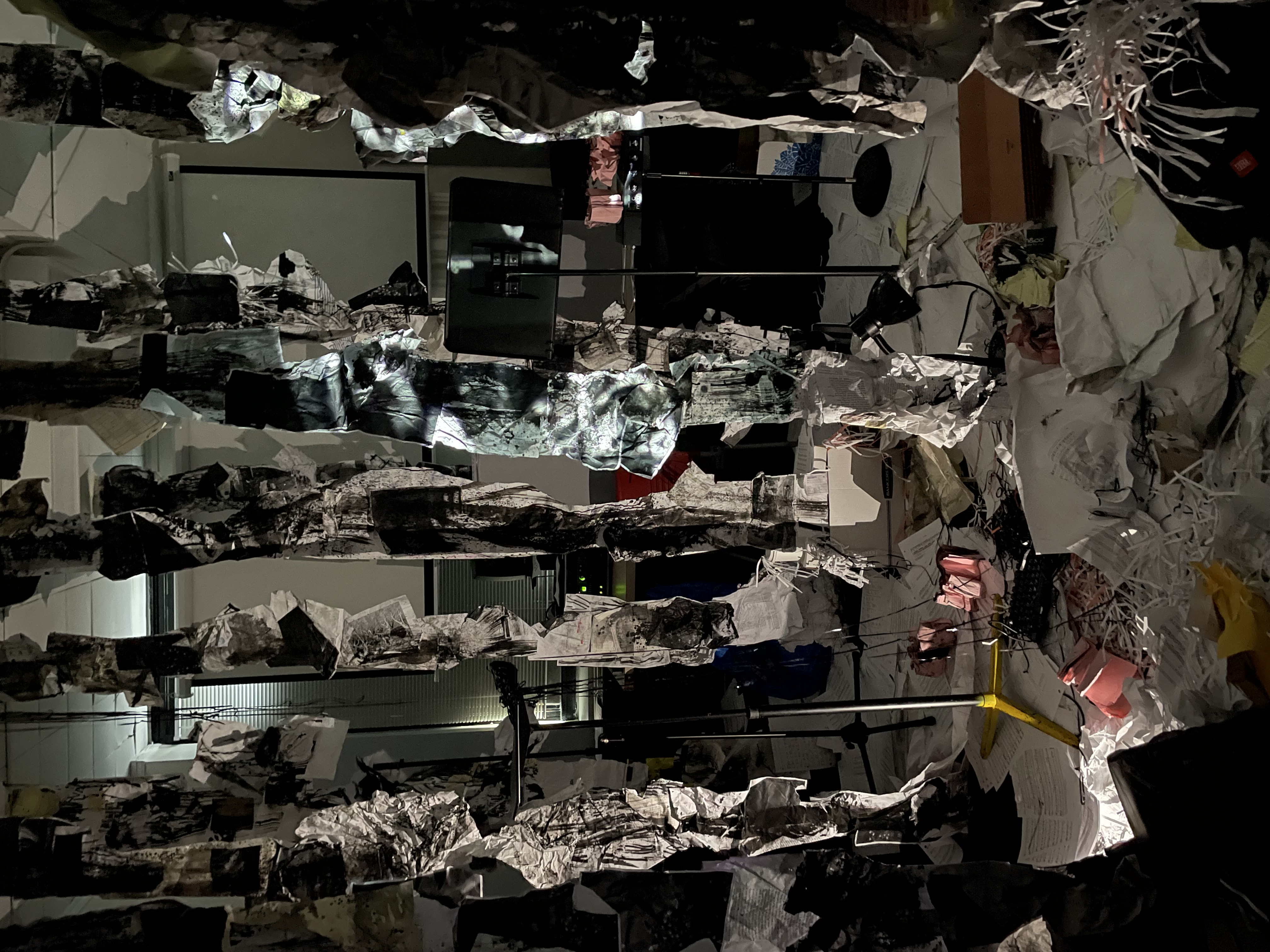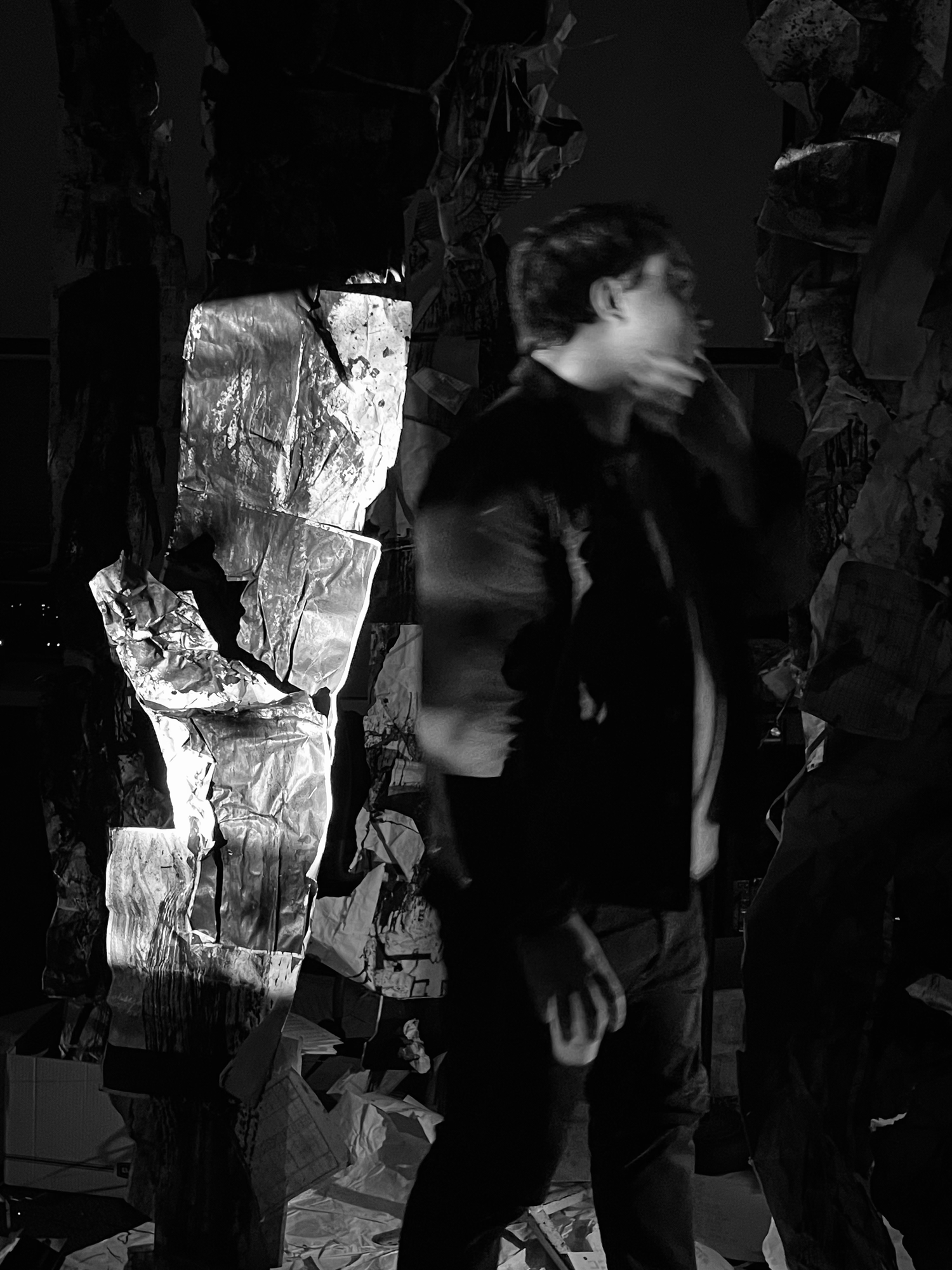INSTALLATION for
THE MANHATTAN SCHOOL OF MUSIC
INFERNO
MUSIC COMPOSED BY THOMAS PALMER IN COLLABORATION WITH
VISUAL MATERIAL BY JOSH OBERLANDER
VOICE BY ALLIE RE
TEXT FROM DANTE, WAGNER, PETER WEISS, GRZEGORZ KWIATKOWSKI, and OTHERS.
“When I had journeyed half our life’s way, I found myself within a shadowed forest.”
A room-sized installation recreating a scene from Dante’s Inferno, the forest of the suicides, made from the texture of late-stage corporate office culture and underscored by a soundscape played on old-school cassette tapes.
--
When Dante’s wrote one of his most enduring works, he blended his own concerns (of his life and legacy, of his lost love, of his exile from home and his alienation all because of his political ambition) with a poetic and imaginative understanding of divine justice, specifically in the various organizations of hell. In many cases, he consulted his own imagination before he consulted liturgy, and imbued his descriptions with characters, conflicts, and details drawn from his own life, and in many cases, Dante’s poetic work has come to usurp actual biblical understanding of cosmological penality. It is one of a handful of received narratives whose elements have become such a cornerstone of Western literature that it no longer becomes important to interact with the source work to receive some of its content – its echoes exist in our day to day life already. In doing so, it becomes a wider reaching word, an associative center point to a web of allusions and themes and we sought to use its text as a jumping off point to explore our own understandings of large themes like Hell/wide-scale penality, torture, penality, spritiuality, in order to create a web of associative allusions ranging from late stage capitalism, death camps, personal stories of loss – all in service of attempting to understand the basic textual impulses Inferno conjures with its vivid descriptions of unfettered cruelty against the body, ordered and maintained by a wide-reaching bureaucratic organization.
Paper was chosen for many reasons: its obvious role in printing and literature, but also because it often warps, creases and bends in response to how it is manipulated – in this sense, the traumas of torture and penality explored in the text, depicted as wrought against the human body, is mapped onto paper as a substitute. The topography of the stairwell was chosen because of the way the modern stairwell is constructed – with its shifting and turning in on itself – feels like a banal and contemporary analogue to the Renaissance diagrams of Dante and Virgil’s descent into Inferno. Visually, Dante’s allusion to what we now might call a mid-life crisis led to the archetypal images of the disposable salary man and an interest in office materials and stationary, the way they blend seamlessly into the background of our comings and goings and the way they can metastasize into images of horror: wet, curling books peeking out of flood water, the stacks of personal papers that fell from the World Trade Center during the September 11th attacks. Inferno is utilized as a mere collection of data inputs (a spreadsheet of verbs drawn from the text) versus scalloped waves of wet and curling paper, twisting with veins made of scotch tape, descriptions of pain and torture crumpled and attached, large drawings of classical scenes of Dante’s set against personal, hand typed descirpitons of loss. The experience of walking through the installation should be as if you’d entered on accident, perhaps hearing a sound you’re not sure of echoing far below – perhaps seeing a stray but unassuming spreadsheet taped to the wall – until you are compelled to go further and further, physically descending, encountering more and more layers of source narratives and different types of “punishments'' enacted through paper and tape, until you reach some sort of terminating source.
THE MANHATTAN SCHOOL OF MUSIC
INFERNO
MUSIC COMPOSED BY THOMAS PALMER IN COLLABORATION WITH
VISUAL MATERIAL BY JOSH OBERLANDER
VOICE BY ALLIE RE
TEXT FROM DANTE, WAGNER, PETER WEISS, GRZEGORZ KWIATKOWSKI, and OTHERS.
“When I had journeyed half our life’s way, I found myself within a shadowed forest.”
A room-sized installation recreating a scene from Dante’s Inferno, the forest of the suicides, made from the texture of late-stage corporate office culture and underscored by a soundscape played on old-school cassette tapes.
--
When Dante’s wrote one of his most enduring works, he blended his own concerns (of his life and legacy, of his lost love, of his exile from home and his alienation all because of his political ambition) with a poetic and imaginative understanding of divine justice, specifically in the various organizations of hell. In many cases, he consulted his own imagination before he consulted liturgy, and imbued his descriptions with characters, conflicts, and details drawn from his own life, and in many cases, Dante’s poetic work has come to usurp actual biblical understanding of cosmological penality. It is one of a handful of received narratives whose elements have become such a cornerstone of Western literature that it no longer becomes important to interact with the source work to receive some of its content – its echoes exist in our day to day life already. In doing so, it becomes a wider reaching word, an associative center point to a web of allusions and themes and we sought to use its text as a jumping off point to explore our own understandings of large themes like Hell/wide-scale penality, torture, penality, spritiuality, in order to create a web of associative allusions ranging from late stage capitalism, death camps, personal stories of loss – all in service of attempting to understand the basic textual impulses Inferno conjures with its vivid descriptions of unfettered cruelty against the body, ordered and maintained by a wide-reaching bureaucratic organization.
Paper was chosen for many reasons: its obvious role in printing and literature, but also because it often warps, creases and bends in response to how it is manipulated – in this sense, the traumas of torture and penality explored in the text, depicted as wrought against the human body, is mapped onto paper as a substitute. The topography of the stairwell was chosen because of the way the modern stairwell is constructed – with its shifting and turning in on itself – feels like a banal and contemporary analogue to the Renaissance diagrams of Dante and Virgil’s descent into Inferno. Visually, Dante’s allusion to what we now might call a mid-life crisis led to the archetypal images of the disposable salary man and an interest in office materials and stationary, the way they blend seamlessly into the background of our comings and goings and the way they can metastasize into images of horror: wet, curling books peeking out of flood water, the stacks of personal papers that fell from the World Trade Center during the September 11th attacks. Inferno is utilized as a mere collection of data inputs (a spreadsheet of verbs drawn from the text) versus scalloped waves of wet and curling paper, twisting with veins made of scotch tape, descriptions of pain and torture crumpled and attached, large drawings of classical scenes of Dante’s set against personal, hand typed descirpitons of loss. The experience of walking through the installation should be as if you’d entered on accident, perhaps hearing a sound you’re not sure of echoing far below – perhaps seeing a stray but unassuming spreadsheet taped to the wall – until you are compelled to go further and further, physically descending, encountering more and more layers of source narratives and different types of “punishments'' enacted through paper and tape, until you reach some sort of terminating source.




